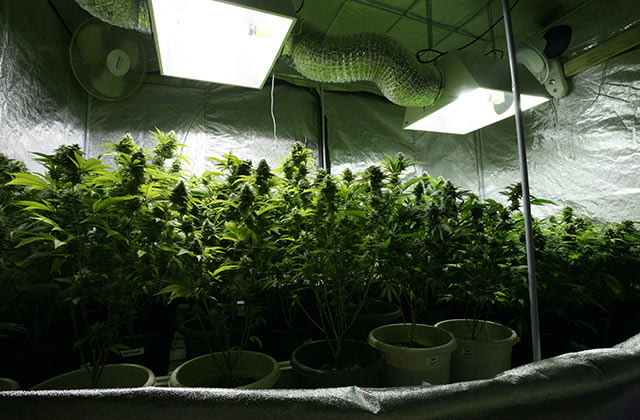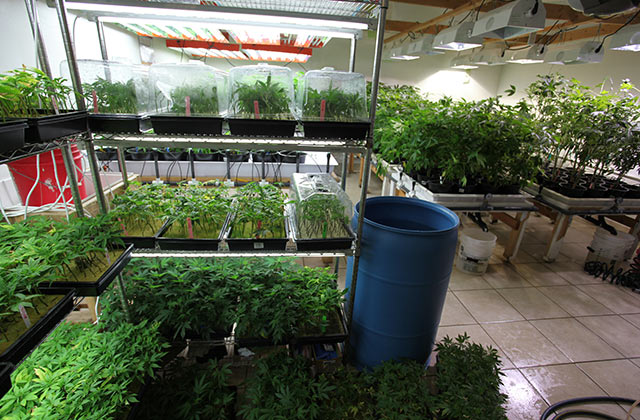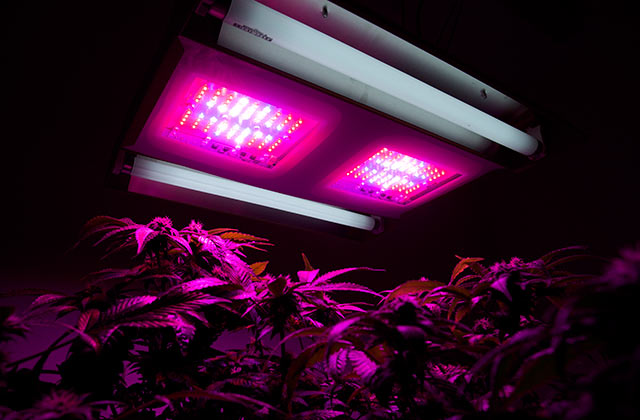There is no better light source for plants than the sun. Therefore, the task of the indoor grower is to reproduce the spectrum and intensity of sunlight as accurately as possible at home. It is still far from the solution of this problem.

Picture. This indoor grow tent uses two MH Marijuana plant grow light
At the same time, artificial lighting for home growing of marijuana offers several advantages. The use of marijuana plant grow light gives us complete control over the conditions in the greenhouse, which is why the quality of the finished product has taken to a whole new level. And yet plant grow light (the so-called lamps for growing plants) often confuse beginners. When the choice is so wide, how do you know which lamps, ballasts and reflectors are the best? As always, the most accurate answer is given by science.
Science tells us exactly what plants need and frees us from doubts. For example, we know that plants need a full spectrum for optimal growth - after all, it's not for nothing that plants have evolved over millions of years under the sun and sky. We also know that plants need a certain amount of light energy for photosynthesis. Only in this case they develop correctly, grow large and give a good harvest of twig cones. So what does agricultural science tell us?
DNAT / MH
Whether you grow in a closet, grow tent, basement or attic, the type of lamp you use has a huge impact on the quantity and quality of your crop. High-power gas discharge lamps DNAT and MH are still the best option for the home grower and serve both amateurs and professionals alike. The question is - what should be the power of the lamp? It all depends on the size of the room, the number of plants that you are going to grow, and your budget.
MH lamps are traditionally used for the vegetative stage, which usually lasts two to four weeks (sometimes longer if you have the time, space and desire to grow trees). MH give a whiter light, that is, blue shades prevail in the spectrum here, due to which the gaps between the nodes are reduced, and the plants turn out to be stocky and branched. This is usually exactly what the home grower needs.
HPS lamps are used during the flowering stage. They have more pronounced orange hues, which is closer to the spectrum of the autumn sun. The extra energy in the red part of the spectrum stimulates the stretching of branches after flowering begins. In all fairness, many experienced growers use both HAP and MH at the same time to get a fuller spectrum and give more energy to the flowering marijuana. Here, of course, it all depends on whether there is space in your room for two lamps and whether you are ready to afford double consumption.

Picture. On the left - clones under fluorescent lamps, and on the right - mother plants under MH.
Among modern models there are also lamps with two bases. They are designed for use with electronic and digital ballasts. they are able to withstand the higher frequency of such ballasts without the shorter lifespan of previous generation lamps. Lamps of this type, for example, Gavita, are usually used instead of HPS, although they have a more complete spectrum, that is, they include more blue colors. Another great type of phyto lamp is CDL (Ceramic Burner Lamp), which are great for growing marijuana. These bulbs are usually less powerful, but still give your garden enough light energy. Both CDLs and Gavitas dual-base lamps get pretty hot, so owners of small boxes should take care of additional cooling.
Energy-saving lamps
Energy Saving Lamps (ECLs) are a great option for hobbyist growers who don't need large yields. ESLs heat very little, give a good spectrum and consume little energy. True, these lamps give little light energy to plants. This is why energy saving lamps are not recommended for the flowering stage and are generally used for sprouts and clones - they get enough light, but it is so soft that it cannot damage them. ESL are also perfect for mother plants or for the vegetative stage in mini-boxes.
LED plant grow light
As we know, two factors influence the development of plants under phytolamps: spectrum and intensity of radiation. Both yield and quality depend on them (in the case of marijuana, psychoactivity). Full spectrum light is as white as the sun. PAR (photosynthetically active radiation) is used to measure light energy. These two factors should be taken into account when evaluating the potential of LED lamps.
LED is a new (just five years) direction in the production of lighting systems for plants. They have their advantages and disadvantages. The advantage is that they consume less energy and heat less than, for example, DNAT. This is a great property for hobby growers and growhouses. However, the disadvantages of LED are also serious. This is a limited spectrum and light energy, which means that the yield of marijuana under LED lamps is low.

Picture. LED plant grow light with side UV tube.
Recent advances in LED technology have overcome some of their disadvantages. New generation LEDs use 5-watt diodes, giving more energy, and more LEDs of different colors are built into the luminaires, which gives a more complete spectrum. However, this progress has been made at the expense of higher energy consumption. Accordingly, such lamps get hotter, and they are much more expensive.























